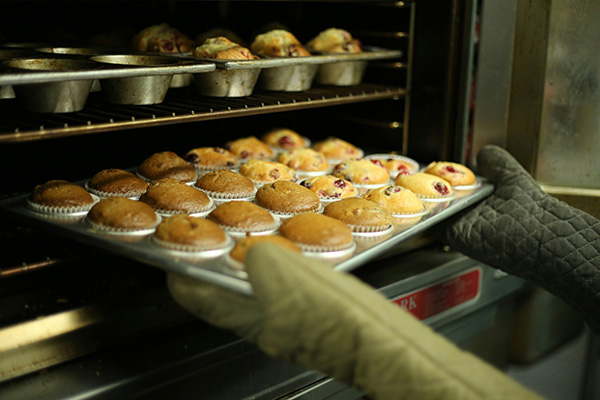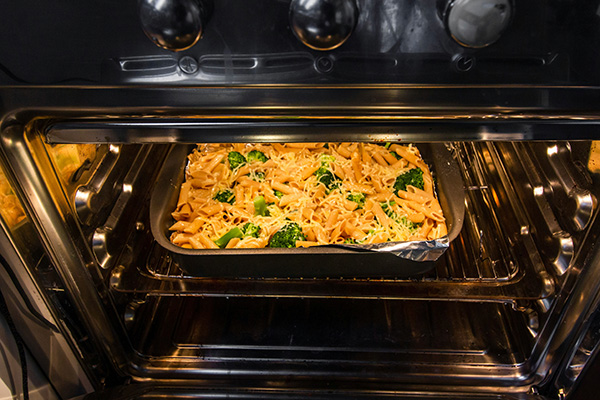Some cooking terms are pretty self-explanatory. It's easy to tell the difference between roasting and, say, boiling. But what about cooking methods that seem significantly more similar - such as convection roast and convection bake options? Both cooking methods use hot air circulated within an oven. Is there any real difference between roasting and baking?
Actually, yes! There are some important differences between these two cooking methods, and knowing these differences will allow you to choose the best method for specific foods or recipes.
What Is Roasting?
Roasting involves cooking foods in an oven, using the heating element at the bottom to heat the air throughout the entire oven. Convection roasting can use both top and bottom heating elements.
Roasting can take place over an open flame, although turning the food regularly to cook evenly on all sides will be necessary. Roasting temperatures occur higher, typically 400 degrees Fahrenheit and above. The higher temperatures used in roasting make caramelization possible, creating a flavorful crust and a beautiful golden brown color.

Benefits Of Roasting
Crispy Texture: The high heat in roasting causes the food's exterior to crisp quickly. This helps to retain moisture that might otherwise evaporate, resulting in dishes that are juicy and full of flavor.
Versatility: Roasting is a cooking method that doesn't necessarily require using a conventional oven! It can occur in convection ovens, a closed barbeque grill, or an open flame.
Enhanced Flavor: Roasting intensifies food's natural flavors. The high heat caramelizes sugars and browns proteins, creating a rich, savory taste.
Variety: Roasting is a versatile cooking technique suitable for various ingredients, including meats, poultry, vegetables, and fruits. This versatility allows for diverse and creative dishes.
Disadvantages Of Roasting
Need Oil or Fat: One of the benefits of roasting is that it supports the development of a caramelized crust. However, the downside is that roast food is often higher in fat. Whether you are cooking food with a high-fat content or adding some oil to a roasting pan of roast vegetables, this cooking method requires ample fat to cook food well.
Time-consuming: Roasting can take longer than other cooking methods, such as grilling or stir-frying. This approach might not be suitable for speedy weeknight meals.
Potential Drying: Overcooking or improper temperature control can lead to dry or tough results, particularly for lean meats or delicate vegetables.
Cleanup: Roasting pans and racks can be difficult to clean, and food residue can sometimes stick, requiring extra effort.
Foods That Are Best Roasted
Roasting is best suited for ingredients with a firm structure, like roasting vegetables and meats. Thick cuts of meat, such as chicken shawarma, whole roasted chicken, benefit from the higher roasting heat to develop flavor and a crispy skin. It's particularly ideal for fatty cuts of meat!
Many vegetables are also delicious when roasting. Roasting causes the vegetables to take on a crunchy exterior and to caramelize slightly. Brussels sprouts and all varieties of root vegetables taste delicious when roasted. A drizzle of olive oil, butter, or other fat boosts the flavor of these savory dishes.
What Is Baking?
Baking also involves cooking foods in an oven, where the top and bottom of the heating elements heat up, and a dry, medium heat to cook the food slowly and evenly. Convection baking typically involves a bottom heating element and has a more gentle airflow.
Baking temperatures typically involve lower temperatures ranging from 175 to 375 degrees Fahrenheit. The lower temperature allows the food to cook more slowly, providing the time necessary for liquid foods to change structure into solid foods.

Advantages Of Baking
Even Distribution: Baking distributes dry heat throughout the entire oven, which means that it cooks food evenly.
Healthier cooking techniques: Baking is one of the healthiest cooking techniques. Compared to other cooking methods like frying, baking results in a significantly lower loss of nutrients. Vitamins and minerals degrade less. It is not necessary to add oil.
Control: Baking gives you much control over the cooking process. Food is cooked at a wide range of temperatures. You can move the oven racks up or down inside the oven to control how close the food is to the heating elements.
Enhanced Flavor and Aroma: Baking often contains natural ingredients and aromas. It can caramelize sugars, creating a pleasant, rich flavor profile.
Hands-Off Cooking: Baking is relatively hands-off once you've placed the dish in the oven, allowing you to focus on other tasks or prepare side dishes while cooking.
Versatility: Baking can be used for various foods, including bread, pastries, casseroles, and roasted meats. This adaptability makes it well-suited for a wide range of culinary creations.
Disadvantages Of Baking
Longer Cooking Times: Baking is typically a longer cooking process. Because the outside of the dish browns so slowly, moisture has time to escape before a crust can form. This can cause meats and other foods to dry out and lose their juicy flavor. There's a reason why roasted meat tastes much better than baked chicken breasts!
Limited Crisping: While baking can produce a crispy exterior in some dishes, it may not achieve the same level of crispiness as frying or grilling.
Foods That Are Best Baked
The lower temperatures used in baking recipes supplied ample time for liquid ingredients to change into a solid structure. This is why baked goods are, well... baked! The batters and doughs have low heat and longer cooking time, which is necessary to change into cakes, brownies, pastries, pasta dishes, and bread.
Whether you use baking pans, baking sheets, or casserole dishes, baking is useful for firming up other liquid foods. For instance, eggs! Whether you simply need to firm up the eggs into a quiche, have eggs as an ingredient in casseroles, or use eggs as a binder in meatloaf, baking is used to change them from liquid to solid.
Roast Vs. Bake: In Summary

Both baking and roasting require using hot, dry heat in an enclosed space to cook food. In comparison to other cooking methods, they share many similarities. Nevertheless, there are a few notable differences.
Food Types: Roasting involves a higher heat and can occur over an open flame! This causes the outside of the food to caramelize and take on a crispy texture, trapping the moisture inside.
Baking is most commonly linked with preparing baked goods, such as bread, cakes, cookies, and pastries. It also includes casseroles, lasagnas, and dishes cooked in an oven-proof container.
Cooking Temperature: Roasting often involves higher temperatures, typically ranging from 300°F (150°C) to 500°F (260°C) or even higher. This high heat helps to brown the exterior of meats and vegetables quickly.
Baking is usually done at lower temperatures, typically between 300°F (150°C) and 375°F (190°C), depending on the recipe. The goal is to cook food evenly without excessive browning.
Cooking Techniques: Roasting may involve techniques like searing or browning meat before placing it in the oven. Basting with juices or fats during cooking is also common. Baking primarily relies on indirect heat, and the cooking process is gentler. There is a reduced focus on browning or searing in the baking process.
Results: Roasting produces foods with a flavorful, crispy exterior and moist interior. It's often used for meats to create a delicious crust and preserve juiciness. Baking results in a wide range of dishes, including bread with a crusty exterior and soft interior, cakes with a moist and tender crumb, and pastries with flaky layers. Baking is a versatile method that can yield both sweet and savory dishes.
Both roasting and baking have their uses in cooking food. Knowing the difference between roasting and baking allows you to cook food using the optimal cooking method to enjoy beautifully crispy roast meats and deliciously sweet, moist cake!

